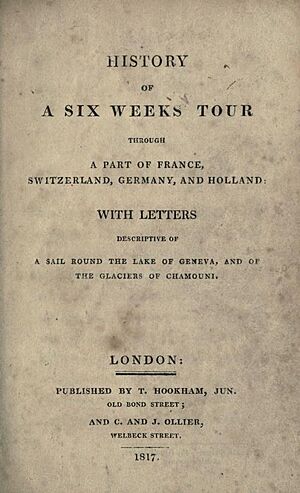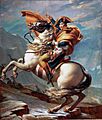History of a Six Weeks' Tour facts for kids
History of a Six Weeks' Tour is a travel book written by English authors Mary Shelley and Percy Bysshe Shelley. It was published without their names in 1817. The book tells the story of two trips they took with Mary's stepsister, Claire Clairmont. The first trip was across Europe in 1814. The second trip was to Lake Geneva in 1816. The book has three parts: a journal, four letters, and Percy Shelley's poem "Mont Blanc". Mary Shelley wrote most of the book. She also organized it. In 1840, she updated the journal and letters. She then put them in a collection of Percy Shelley's writings.
This book was part of a new type of writing called the Romantic travel story. It shows excitement and a desire to explore. The authors wanted to develop their own style. They also wanted to stand out from others. The romantic parts of the book hinted at its strong political ideas. These ideas were unusual for a travel book at that time. Especially since a woman wrote most of it. The book openly talked about politics. It spoke positively about the French Revolution. It also praised Enlightenment thinker Jean-Jacques Rousseau.
History of a Six Weeks' Tour did not sell many copies. But it received good reviews. Mary Shelley later said that her "6 weeks tour brought me many compliments." This was when she suggested another travel book to her publisher in 1843.
How the Book Came to Be
Mary Godwin and Percy Shelley met in 1814. They soon fell in love. Percy Shelley first visited Mary's home to meet her father, William Godwin. He was a famous thinker. Mary and Percy started meeting in secret. Percy was already married. Mary's father did not approve of their relationship. He tried to stop it. On July 28, 1814, Mary and Percy secretly left for France. Mary's stepsister, Claire Clairmont, went with them.
The three traveled for six weeks. This was from July 28 to September 13, 1814. They went through France, Switzerland, Germany, and the Netherlands. They had to return to England because they ran out of money. When they came back, things were difficult. Mary was pregnant. Her baby would soon die. She and Percy had no money. Mary's father was very upset. He refused to have anything to do with her.
In May 1816, Mary Godwin, Percy Shelley, and their second child traveled to Geneva. Claire Clairmont joined them. They spent the summer with the poet Lord Byron. Mary Shelley later wrote about that summer. She said it was "a wet, ungenial summer." It rained so much that they often stayed inside for days. The group spent their time writing. They also boated on Lake Geneva. They talked late into the night. One evening, they sat by a fire at Byron's house. They read German ghost stories. This made Byron suggest they each write their own scary story. Mary Godwin started writing what she thought would be a short story. But Percy Shelley encouraged her. With his help, she turned it into her first novel. It was called Frankenstein.
Mary, Percy, and Claire returned to England in September. On December 30, 1816, Percy and Mary got married. This helped heal the family problems. In March 1817, the Shelleys and Claire moved to Marlow, Buckinghamshire. In Marlow, they had friends over. They worked hard on their writing. They often talked about politics. In early summer 1817, Mary Shelley finished Frankenstein. It was published in January 1818. She also started working on History of a Six Weeks' Tour. This book was published in November 1817.
Images for kids
-
Percy Bysshe Shelley was inspired by William Godwin's ideas. (Amelia Curran, 1819)
-
Mary Shelley wrote that the 1814 trip felt like "acting in a novel." (Richard Rothwell, 1840)
-
The group read Mary Wollstonecraft's Letters Written in Sweden, Norway, and Denmark. This influenced History of a Six Weeks' Tour.
-
Napoleon Crossing the Alps by Jacques-Louis David (1801–05).
-
A reviewer compared Lady Morgan to the writer of History of a Six Weeks' Tour. The reviewer liked the Tour more. They seemed to miss the similar ideas in Mary Shelley's writing.
See also
- Mary Shelley bibliography









